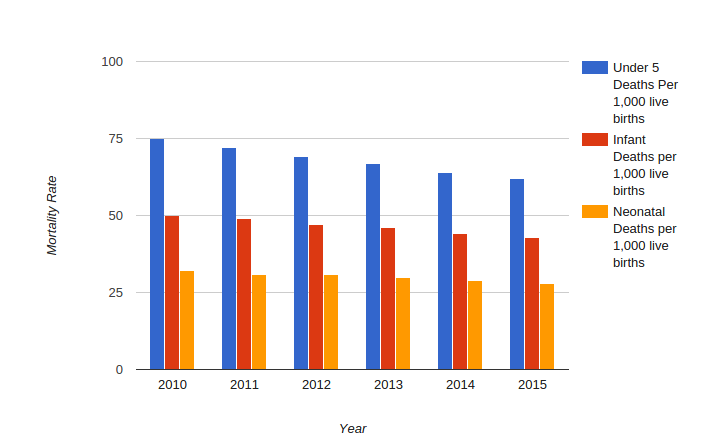Child Mortality and Sanitation in Ghana 2015

The Millennium Development Goals are time-bound targets set by one of the greatest gathering of world leaders in history to combat poverty, hunger, diseases, lack of adequate shelter etc. in the world. The goals were set to better the living conditions of citizens of the countries represented at the summit.
There are eight goals in all; goal number 4 is aimed at the reduction of child mortality. All the goals are supposed to be achieved by 2015 by all the nations represented at the summit. We are well into the year 2015, though the year is not over yet, there have been some statistics available to show which countries are on their way to the achievement of these goals and which are still lagging behind. Our main focus for this post is goal number 4: reduction of child mortality, especially in Ghana.
The Reduction of Child Mortality goal is a global goal, hence every country represented at the summit is expected to achieve it by 2015. There are more developed countries who are likely to achieve this quicker than the rest; this is actually the situation on the ground, where we have seen that there is no uniformity in its achievement all over the world. The target to be achieved when it comes to Child Mortality is 41 deaths per 1,000 live births; every country is supposed to reduce Child Mortality to this figure by 2015. Between 1990 and 2002, child mortality has been reduced from 103 to 88 deaths per 1,000 live births.
As stated already, this fact is not uniform across all countries represented at the summit. However, it is 2015 and Ghana has not achieved the target. The Child Mortality rate stands at 62 deaths per 1,000 live births in Ghana as compared to the target of 41 deaths. This is especially alarming because the causes of these deaths are totally preventable. Some of the causes of the deaths are: diarrhoea, malaria, neonatal infections, pneumonia, preterm delivery, or lack of oxygen at birth. According to UNICEF, a newborn baby dies every 15 minutes and the death of newborn babies makes up 50% of all infant deaths. This is very alarming and must be given the necessary attention and measures must be taken to curb the child mortality rate in the country.
Closely linked with the rate of child mortality in Ghana is the poor sanitary conditions in most parts of the country. This is due to a lack of sanitation facilities and poor practices in our communities. Taking a critical look at the sanitation facilities in Ghana, we can see a steady improvement over the last couple of years; but this is still not good enough since the figures are very low. Open defecation and refusing to wash the hands after using the toilet increase the chances of coming into contact with human excreta. This also increases the chances of one contracting some diseases. According to the World Bank:
Access to improved sanitation facilities refers to the percentage of the population using improved sanitation facilities. Improved sanitation facilities are likely to ensure hygienic separation of human excreta from human contact. They include flush/pour flush (to piped sewer system, septic tank, pit latrine), ventilated improved pit (VIP) latrine, pit latrine with slab, and composting toilet.
It is therefore disappointing to discover what the statistics say concerning the percentage of Ghana’s population that has access to sanitation facilities. As at 2010, 13.7% of the country’s population had access to sanitation facilities. In 2015, 14.9% of the population has access to sanitation facilities. This is alarming considering the fact that this includes all the urban centers scattered all over the country. The problem is widespread. Those living in Accra can attest to the fact that the situation is no different in the country’s capital; it could even be worst in Accra. The capital city - though an urban center - is gradually becoming the city with the poorest sanitary conditions in the country: slums sprout out of nowhere and everywhere; there is open defecation in these slums; waste management is very poor; gutters are not desilted etc. All these culminate to make these communities a safe haven for bacteria that cause diseases.
We are in the year 2015, and about 85% of the country’s population doesn’t have access to sanitation facilities (places of convenience, handwashing facilities etc.). Also, Ghana is well short of achieving the global goal of 54% improved sanitation rate by 2015. This is a health issue since sanitation is directly related to the health and well-being of human beings. According to a UNICEF report:
Handwashing can reduce diarrhea and pneumonia by up to 50%, yet less than 15% of Ghanaian households have handwashing facilities. Improved sanitation can reduce diarrhea rates by 36%, but only 15% of Ghanaians have access to improved sanitation…
Improved sanitation is a saviour; it is a preventer of unnecessary deaths. Therefore much attention must be paid to it and resources made available to improve sanitary conditions all over the country. This is where we link the poor sanitary conditions in the country to the child mortality rate. About 4,000 Ghanaian children die of diarrhea and many more die of pneumonia each year. All these deaths could be prevented by improved sanitation: provision of sanitation facilities and washing of the hands after using the places of convenience. We are losing too many - especially children - to diarrhea and pneumonia which can both be easily prevented by improved sanitation.
